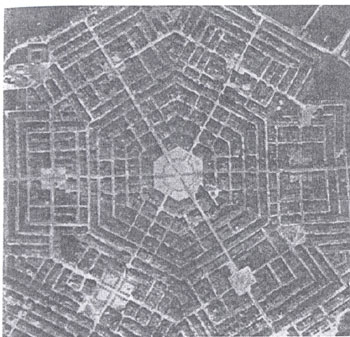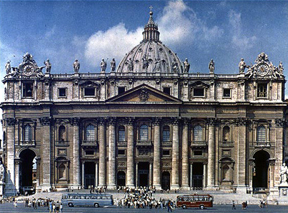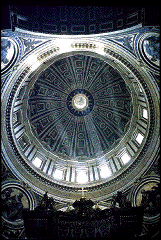MATH 7210 : Foundations of Geometry
II
University of Georgia, Spring
2001
Dr. McCrory, Instructor
Rotational and Reflectional
Symmetry
In rotational and reflectional symmetry, there
is a central point that is the center of rotation and the point
of intersection of the reflection mirrors. This symmetry type
is comparable to dihedral wheel patterns but can be either 2-D
or 3-D.
Resource: Williams, Kim (1998). Symmetry
in Architecture. (http://turing.mi.ssau.ac.yu/vismath/kim/)
Example 1: Pentagon
 Location: Washington, D.C.
Architect: George Edwin Bergstrom
Building Type: Office building
Symmetry: The center is the building in the
middle of the courtyard, and the mirrors each contain a vertex.
The Pentagon is comparable to a D5 or (*5) wheel pattern.
Resource: Blackwell, William (1984). Geometry
in Architecture. pg. 51.
Location: Washington, D.C.
Architect: George Edwin Bergstrom
Building Type: Office building
Symmetry: The center is the building in the
middle of the courtyard, and the mirrors each contain a vertex.
The Pentagon is comparable to a D5 or (*5) wheel pattern.
Resource: Blackwell, William (1984). Geometry
in Architecture. pg. 51.
Example 2: City of Granmichele
 Location: Sicily, Italy
Architect: ???
Architecture Type: Aerial view of city layout
Symmetry: The center of this seemingly D6 or
(*6) wheel pattern is the middle of the city. Three mirrors are
the roads that run through the center of the city. The other three
mirrors contain opposite vertices of the visibile hexagon.
Resource: Blackwell, William (1984). Geometry
in Architecture. pg. 27.
Location: Sicily, Italy
Architect: ???
Architecture Type: Aerial view of city layout
Symmetry: The center of this seemingly D6 or
(*6) wheel pattern is the middle of the city. Three mirrors are
the roads that run through the center of the city. The other three
mirrors contain opposite vertices of the visibile hexagon.
Resource: Blackwell, William (1984). Geometry
in Architecture. pg. 27.
Example 3: St. Peter's Basillica
Location: Vatican City, Rome, Italy
Architect: Giacomo della Porta
Building Type: Church
Symmetry: The center of this 3-D rotation is
the central vertical axis through the dome. The mirrors pass through
this axis, and half of them contain the blue lines (right photograph)
while the other half are exactly between the blue lines. This
example is comparable to a 2-D D16 or (*16) wheel pattern.
Resources: Sweet Briar College, Professor Christopher
L.C.E. Whitcombe (http://www.arthistory.sbc.edu/sacredplaces/stpeters.html)
Tulane University, Professor Hugh Lester (http://www.tulane.edu/lester/text/Renaissance/Italian.Renaissance/Italian.Renaissance120.html)
Go
to Bilateral Symmetry (Back)
Go
to Cylindrical Symmetry (Next)
Return to
Main Page




